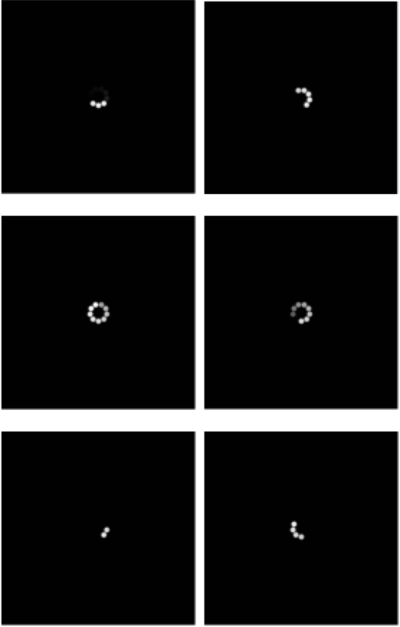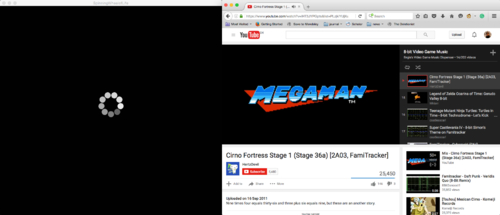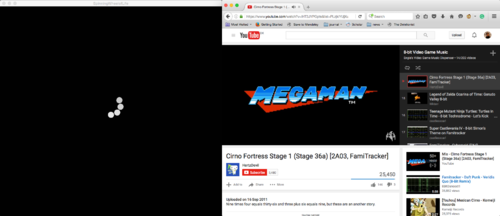Difference between revisions of "Exe0.2 Winnie Soon"
| Line 18: | Line 18: | ||
Data is transmitted extremely fast and in vast quantity in contemporary software culture, and such conditions do not favour a close examination of computational processes that happen behind a digital and cultural object like a throbber. On the contrary, David Berry suggests, "if the speeds of the computers were slowed down, we would be able to watch our computers tick through their actions in real time". | Data is transmitted extremely fast and in vast quantity in contemporary software culture, and such conditions do not favour a close examination of computational processes that happen behind a digital and cultural object like a throbber. On the contrary, David Berry suggests, "if the speeds of the computers were slowed down, we would be able to watch our computers tick through their actions in real time". [1] The work takes the strategy of slowing down the running code and selecting a smaller stream source so as to capture the background processes of synchronisation, operations and executions. Considering a stream as a metaphor, things do not always flow smoothly, uninterruptedly and continuously.[2] A stream contains a series of chopped packets that produce differences and rhythms through their transmission journeys. Buffering is a coupling of storage and transfer, [3] and a buffer refers to temporary memory in which writing and reading of data are processed at different rates. [4] More importantly, viewers are not watching or listening to the content as data arrives. Instead, they are experiencing the processed data that has arrived and stored in the buffer. At a microscopic level, there is latency between data arrival, data storage and data processing that are not apparent to us. | ||
Revision as of 17:30, 22 April 2016
The Spinning Wheel of Life (2016)
This work draws upon my previous working article from exe0.1- [At the time of execution: throbber.start()]
Screenshots:
Description:
The project challenges the perception of a throbber that is usually understood as a transitional object, waiting for content delivers on a screen. By having a music stream that runs in the background, the throbber appears not because of waiting for data arrival, but, instead, it spins as the machine receives data and stores them in a buffer. The project asks: how might we engage with a throbber beyond the negative connotations of waitings, frustrations and annoyance in contemporary software culture?
Data is streamed through different speeds and sites across network connections, devices and nodes. The work reveals the microtemporality of a data stream that is not often made visible to us. Instead of presenting a throbber that spins at a constant speed, the project makes apparent the real-time network traffic at a microscopic level through the display of repetitive but different tempo of ellipses.
Data is transmitted extremely fast and in vast quantity in contemporary software culture, and such conditions do not favour a close examination of computational processes that happen behind a digital and cultural object like a throbber. On the contrary, David Berry suggests, "if the speeds of the computers were slowed down, we would be able to watch our computers tick through their actions in real time". [1] The work takes the strategy of slowing down the running code and selecting a smaller stream source so as to capture the background processes of synchronisation, operations and executions. Considering a stream as a metaphor, things do not always flow smoothly, uninterruptedly and continuously.[2] A stream contains a series of chopped packets that produce differences and rhythms through their transmission journeys. Buffering is a coupling of storage and transfer, [3] and a buffer refers to temporary memory in which writing and reading of data are processed at different rates. [4] More importantly, viewers are not watching or listening to the content as data arrives. Instead, they are experiencing the processed data that has arrived and stored in the buffer. At a microscopic level, there is latency between data arrival, data storage and data processing that are not apparent to us.
The Spinning Wheel of Life addresses multiple executions occur along the journey of network transmission and data processing. There are different rates, tempo, pulses, pauses and rhythms at multiple scales - from the operations of the CPU to network routers, from the transmissions of senders to receivers, from the writing to the reading of buffers, and from continuous streams to discontinuous packets. The Spinning Wheel of Life is a reflection on the microtemporal complexity of operative processing, constantly rendering the now in this pervasive, timely and networked conditions. The notion of nowness lies beyond the human perception or immediate reception of content representation. Seemingly, from social media and infotainment to transactional processes, the multiplicities of microtemporal activities actively constitute the nowness of contemporary software culture.
[side note1]The title of the project is borrowed from a ‘wait cursor’ in the Macintosh Operating System X designed by Apple. The wait cursor is colloquially known as “The Spinning Wheel of Death”, referring to the malfunction or failure of a running program or a system that leads to screen freezes. The name takes on negative connotations as the problems are usually difficult to diagnose.
[side note2]The use of the word ‘life’ is referenced from a field in TCP specification: Time to Live (TTL), which limits the lifespan of data within a connection. Between a network transmission, the journey made up of multiple ‘hops’. TTL is defined as the number of hops that a packet has to pass through before reaching its destination. This also means that if a packet passes through more than a defined number of hops, the packet is being discarded, meaning it will be time to die as opposed to live. Therefore, each packet has its lifespan and its own state of life or death.
Video documentation (work in progress):
4 mins video [here]
Date: 18 Apr 2016, 15.30 - Aarhus, Denmark
Ideal setup and how it works:
Ideally, it is an installation work that displays the visual on screen and comes with a headphone. A dynamic throbber is visually presented (only a throbber but no youtube screen) and an audience will hear the youtube 8-bit video game music playlist, and both are run in real time.
How it works: A software is made in processing, constantly listening to a range of IP addresses in real-time. Each display of an ellipse is subjected to network packet arrival. A series of the ellipse will form a noticeable and animated icon - throbber.
Source Code:
See: https://github.com/siusoon/The-Spinning-Wheel-of-Life


